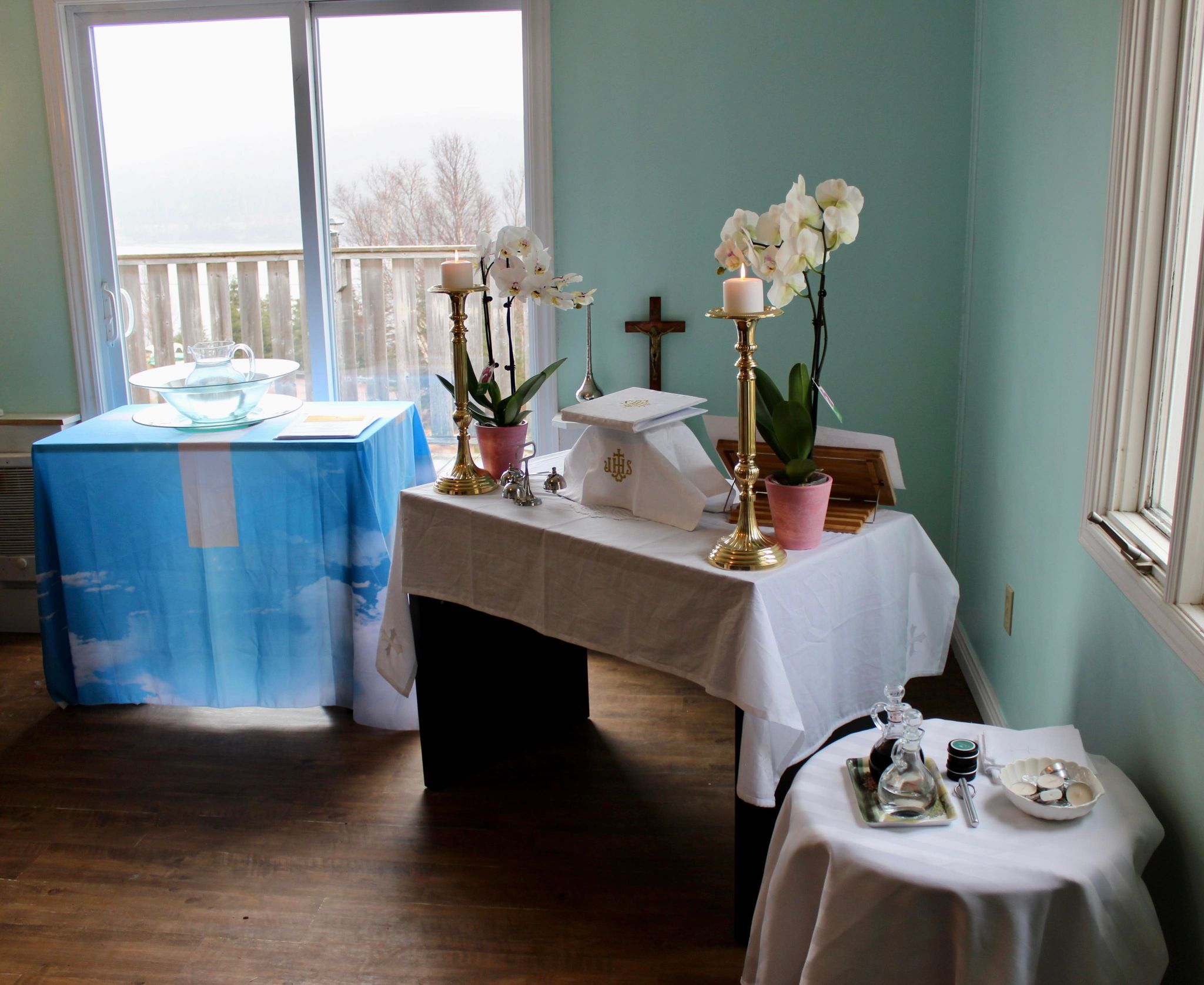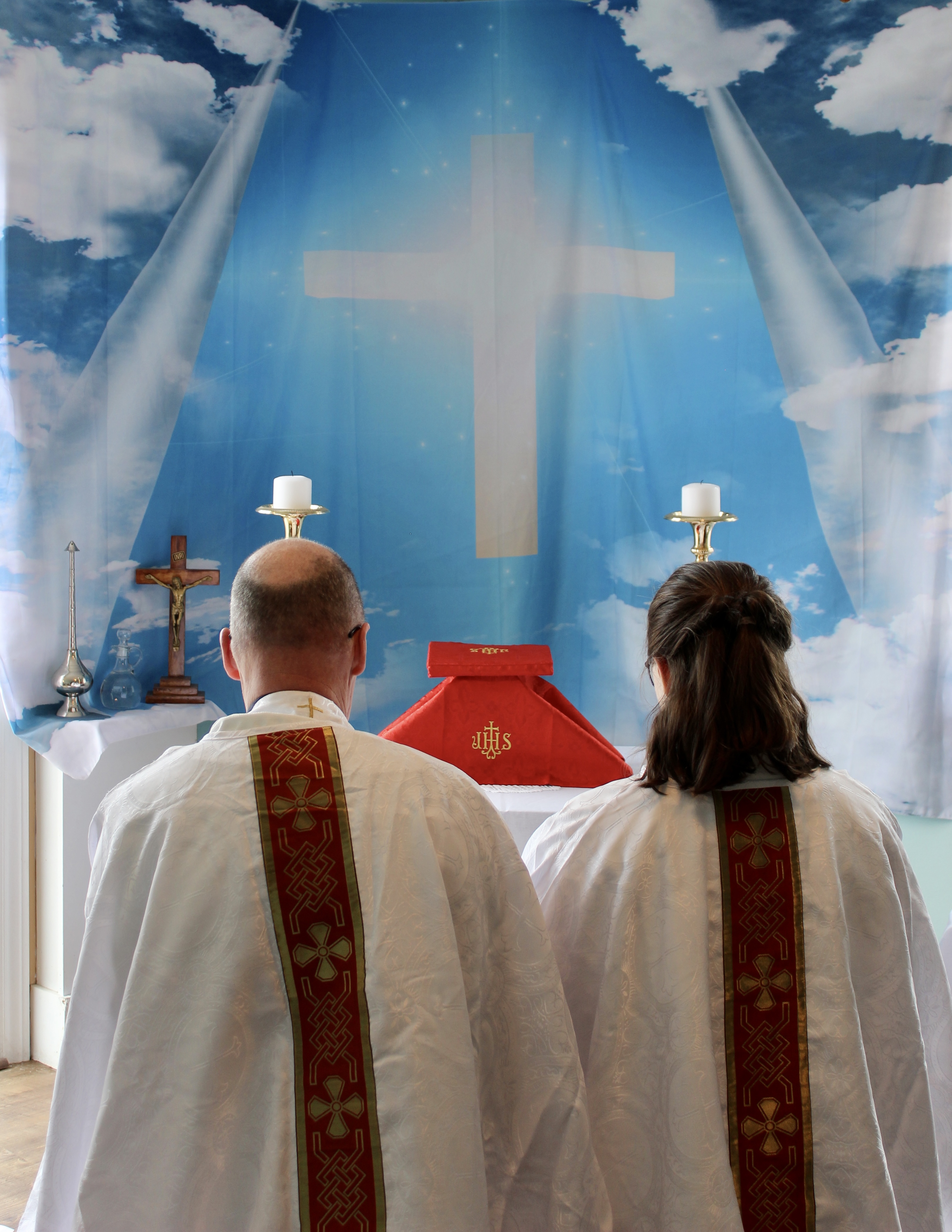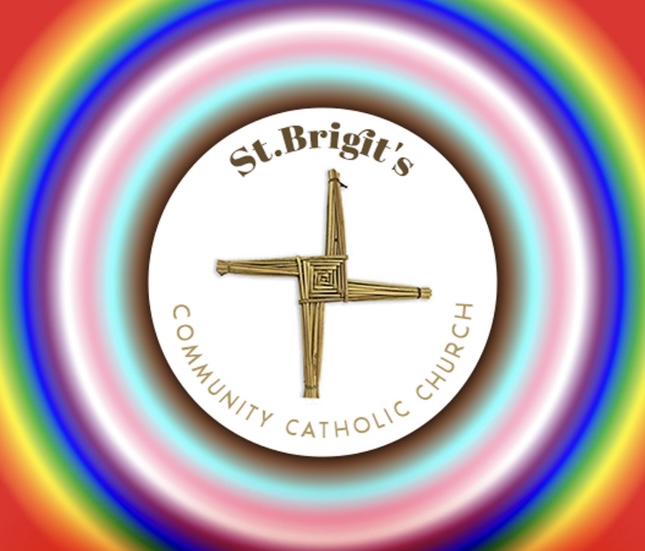- Home
- about stbrigits
- Religious Demographics for Newfoundland
Simply Catholic and Welcoming You
Religious Demographics for Newfoundland

An Altar Flanked by a Credence Table and a Baptismal Font - Inviting ALL to Come Worship Christ.
In 2021, the religious demographics for Newfoundland showed that the dominant religions in Newfoundland and Labrador were Catholic (31.8%) and Anglican (21.5%), but there was also a significant population with no religious affiliation (27.7%), a notable increase from 2011. Other Christian denominations, like the United Church (12.1%) and Pentecostal (5.7%), were also present, though a growing diversity of other faiths is emerging with new immigration.
Here's a breakdown of the major religious groups in Newfoundland and Labrador by percentage in 2021:
Christian Denominations:
- Catholic: 31.8%
- Anglican: 21.5%
- United Church: 12.1%
- Pentecostal and other Charismatic: 5.7%
- Christian, n.o.s.: 1.1% (not otherwise specified)
- Presbyterian: 0.2%
- Lutheran: 0.1%
- Christian Orthodox: 0.1%
- Baptist: 0.2%
Other Religions:
- Buddhist: 0.1%
- Jewish: 0.0% (220 people)
No Religion:
- No religious affiliation: 27.7%
Key Trends:
- Declining Christian Adherence: There has been a steady decrease in the percentage of people identifying with traditional Christian denominations, particularly the United Church and Anglicanism.
- Growing Secularism: The proportion of people reporting no religious affiliation has significantly increased, mirroring broader Canadian trends.
- Increasing Diversity: While historically dominated by Christianity, immigration is bringing a wider range of religious groups to the province, though these populations remain small.
- "Heritage" vs. Belief: Some individuals may still identify with a religion for cultural or heritage reasons rather than strong personal belief.
Religious Demographics for Newfoundland - Religious Segregation

Husband and Wife Clergy Genuflect in Front of The Altar Before Celebrating Mass - Where ALL Are Welcome to Worship and Receive The Holy Eucharist
Since St. Brigit’s Community Catholic Church has our home base in Newfoundland,Canada, understanding something of the religious demographics and segregation historically and currently in Newfoundland, as well as the overview throughout Canada, is important to us.
Religious segregation in Newfoundland was primarily characterized by its denominational school system, which separated students by Christian faith and persisted until a constitutional amendment in 1997 established a single, non-denominational public system. This segregation extended to discriminatory policies in education, with hiring and school board elections tied to religion, and faced significant criticism and activism, particularly from the Newfoundland-Labrador Human Rights Association. While the education system has changed, historical patterns of religious influence have shaped social institutions.
Historical Context
- Church Dominance: Early English and Irish settlers established a system where Christian churches, primarily Catholic and Protestant, established and then controlled schools for over 150 years.
- Denominational Schools: Schools were segregated by religion, with separate Catholic and Protestant schools existing for centuries.
Impact and Discrimination
- Discriminatory Policies: The system had formal policies allowing for religious discrimination, such as candidates for school boards having to be of a specified faith and teachers being hired based on their religion.
- Unequal Access: Student entrance to certain schools or programs was sometimes based on religious affiliation.
- Teacher Denials: In 1972, a woman was denied a teaching certificate for refusing to state her denomination, highlighting the system's strict religious control.
The Push for Change
- Activism: The Newfoundland-Labrador Human Rights Association (NLHRA) and student committees at Memorial University campaigned against the discriminatory system.
- Referendum: In 1997, a provincial referendum approved the elimination of the separate school system.
- Constitutional Amendment: In 1998, a constitutional amendment removed the province's obligation to maintain confessional (religious) schools.
The Current System
- Non-Denominational: Newfoundland and Labrador now has a single public, non-denominational school system, ending over 150 years of church control.
- Equality Focus: The change aimed to create a more equitable system where all students and parents could participate equally, promoting tolerance and integration.
Other Forms of Religious Segregation
- Residential Schools: A history of abuse in residential schools for Indigenous peoples further illustrates how religious institutions have impacted marginalized communities in the province.
Yes, there were residential schools in Newfoundland and Labrador, though they were not part of the original Federal Indian Residential Schools Settlement Agreement. Five residential schools operated in the province, with three in Labrador (Lockwood School, Makkovik Boarding School, Nain Boarding School) and two in Newfoundland (St. Anthony Orphanage and Boarding School, Yale School).
- The schools were operated by the Moravian Mission, International Grenfell Association, jointly with the province of Newfoundland and Labrador, with the last one closing in 1980.
- Students were removed from their families and communities and were subjected to policies of assimilation.
- In 2017, the Prime Minister of Canada delivered an apology on behalf of the government for the harm caused by these schools.
- A separate settlement agreement was reached in 2016 for survivors of these Newfoundland and Labrador schools.
- Social Institutions: The legacy of religious influence extends beyond education, shaping various social institutions throughout the province's history.
For over 150 years, the most prominent form of religious segregation in Newfoundland was its publicly funded denominational school system, which was dismantled in 1997. This system entrenched divisions between Christian denominations, particularly between Catholics and Protestants. While this official segregation no longer exists, other forms of religious intolerance and discrimination persist.
Legacy of the denominational school system
Until the 1990s, Newfoundland's education system was segmented along religious lines, with publicly funded schools operated by various churches. This created a lasting legacy of religious divisions that influenced the province's social and political life.
- Political divisions: From the mid-19th century until Confederation, Newfoundland politics were often segregated along religious lines. Electoral districts, public sector jobs, and other forms of patronage were divided between Protestants (primarily of English descent) and Catholics (primarily of Irish descent).
- Discrimination against minorities: The denominational system primarily protected the rights of larger Christian denominations, leaving religious minorities like Seventh-Day Adventists with limited options. The system was also criticized for failing to accommodate students who did not belong to one of the recognized denominations.
- Religious identity: The denominational system reinforced sectarian identities and a sense of "us versus them" based on religion, even influencing school busing routes. While the system is gone, social divisions and tensions can still linger.
Contemporary forms of religious discrimination
In modern Newfoundland and Labrador, other, more subtle forms of religious prejudice and discrimination can still occur, particularly for non-Christian faiths and newer immigrant communities.
- Systemic racism and intolerance: A 2021 project at Memorial University, "Addressing Islamophobia in NL," highlighted that Islamophobia exists in Newfoundland and Labrador, and like other forms of racism, it manifests in ideological, systemic, and intersectional ways.
- Microaggressions: Religious intolerance can appear in subtle, everyday acts of exclusion known as microaggressions. Examples include making insensitive jokes about a faith, assuming a person of a particular faith is new to Canada, or holding meetings on religious holidays.
- Hate crimes: Data from the Canadian Human Rights Commission shows an increase in police-reported hate-motivated crimes targeting religion across Canada between 2019 and 2021. Many of these incidents also go unreported.
- Social and cultural exclusion: As Newfoundland and Labrador's population becomes more diverse, some residents from non-Christian faiths may experience feelings of 'othering' or being unwelcome. This can happen in social settings, workplaces, and institutions where the dominant Christian culture is assumed.
Protective measures
The Human Rights Act of 2010 in Newfoundland and Labrador is designed to combat religious discrimination. The act explicitly prohibits discrimination and harassment based on "religious creed" and "religion" in areas such as employment, public services, and accommodation. The Newfoundland and Labrador Human Rights Commission also offers a service called "Community Justice Connect" to assist Indigenous, racialized, and religious minority communities facing conflict and racism.
Religious Demographics throughout Canada

The Logo of St. Brigit's Community Catholic Church - Designed to Signify That ALL Are Welcome In Our Community For Fellowship, Worship and to Receive the Sacraments of the Christian Faith
Throughout Canada, Christianity is the largest religious group at 53.3% of the population, followed by those with no religious affiliation at 34.6%. Other common religions include Islam (4.9%), Hinduism (2.3%), and Sikhism (2.1%). The percentage of Christians has declined while the proportion of people with no religious affiliation and those identifying with other religions has grown.
Religious affiliation in Canada (2021 Census)
- Christian: 53.3%
- No religious affiliation: 34.6%
- Islam: 4.9%
- Hinduism: 2.3%
- Sikhism: 2.1%
- Other religions: 12.1%
Key trends
- Christianity: The percentage of Canadians identifying as Christian has decreased over the last 20 years, from 77.1% in 2001 to 53.3% in 2021, a 23.8% decrease. Most Christian churches are seeing only 10% to 22% attendance now compared to what the individual church buildings were built to hold. Meaning that even those identifying as Christian are not actually attending church services regularly.
- No religious affiliation: The proportion of people with no religious affiliation has more than doubled from 16.5% in 2001 to 34.6% in 2021, an 18.1% increase.
- Growth in other religions: The proportion of the population reporting Muslim, Hindu, or Sikh affiliations has more than doubled between 2001 and 2021 due to immigration.
What do these demographics actually tell us?
Firstly, it must be noted that the legal changes, especially in Newfoundland, are relatively recent. It is also true that, in Newfoundland, many communities, including whole towns, are still predominately or exclusively made up of only one denomination.
For the Atlantic provinces and Newfoundland in particular, immigration is dramatically changing the religious demographics as new immigrants bring other religions into the country and the province. The speed of these changes may contribute to the resistance or push back by those locals from established denominations and faiths where the belief or fear is that this influx is a threat to their own faith.
Christianity is dwindling in our province and country for a variety of reasons discussed elsewhere on this website. The decline is real and forcing the restructuring of the established major religions including the closing of churches on grounds of economy and clergy shortages.
The number of people with no religious affiliation is also growing rapidly. The youth especially are shying away from religion which they today perceive as controlling and abusive while failing to see the advantages of a strong faith in their personal, family and community lives.
In many ways it is the failures of the established religions and denominations that have produced outcomes that were long predictable yet never grasped or understood by aging leadership who continue to fail to understand that today's youth are information rich, even while older congregation members are disillusioned and saddened by their churches histories or abuse, cover ups and a general dissociation from the needs and expectations of the general membership of the faithful.
Yet there is also hope in these numbers! Churches that can set aside their systemic blindness to the needs of the people and the true mission of Christ Jesus can absolutely thrive.
We continue to say it - people don’t care what you know or want until they know that you care!
People today as much if not more than at any other time want and need to be seen and heard. To have a church meet their needs instead of always having their hand, the donations box, foremost in the church's interests.
People are experiencing a sense of loss they cannot quite name in their lives. Busy schedules. Digital domination. The breakdown of families and not just of church communities but communities in general. Whether they know it or not they are looking for a sense of connection best met by a strong faith and a strong faith community.
The pendulum will swing but only if church leaders are willing to move into the 21 st century and meet people where they live and where they each uniquely need to be met, valued, understood, welcomed and celebrated as Christ Himself showed by His own life's example.
Too many religions and denominations are like the Pharisees and Sadducees of old whom Christ told they were putting too many rules, the requirements of men, on to the faithful and thus keeping them from God!(Matthew 23)
It is long since high time churches and denominations stopped trying to make people conform to their ideals of whom should belong and work on conforming churches to actually follow Christ's teachings to Love All, accept All and Judge Not
We must stop causing people to leave their faith and begin to truly welcome people into church environments where questions are welcome and their individual and community involvement is valued and celebrated.
Recent Articles
-
Catholic Priests and Deacons Have Vesting Rituals and Prayers
Nov 29, 25 06:02 PM
Catholic priests and deacons have vesting rituals and prayers where they recite specific prayers while donning each vestment, a ritual known as "vesting," -
Church Buildings as Assets
Nov 29, 25 05:12 PM
Congregations should see their buildings as assets, not unwieldy expenses -
womenclergy
Nov 22, 25 03:24 PM
Women clergy are officially excluded from the Catholic church yet evidence exists that women held leadership roles in the early church
Boat Harbour West, Newfoundland, Canada. Cell Number 709-276-0626


